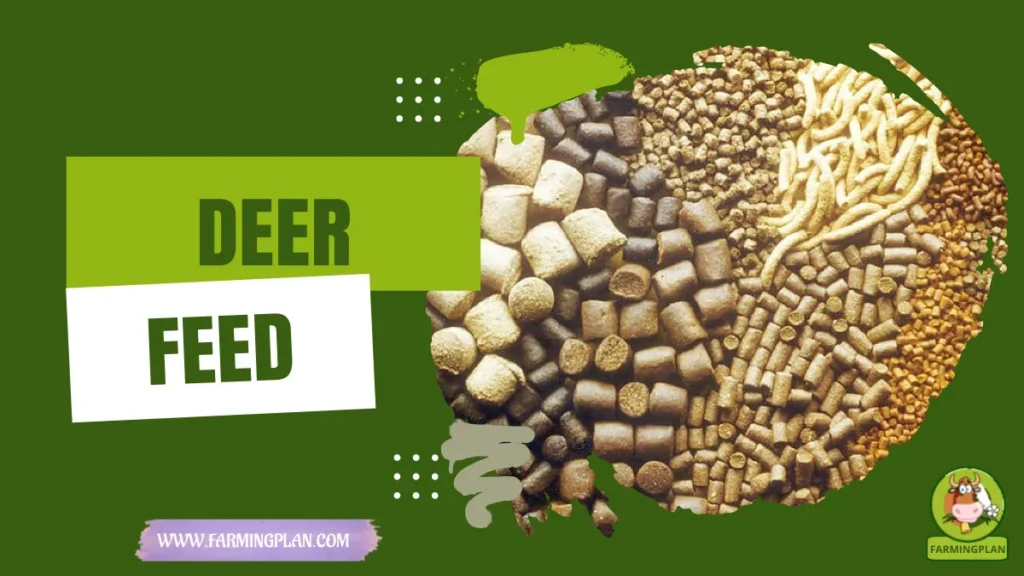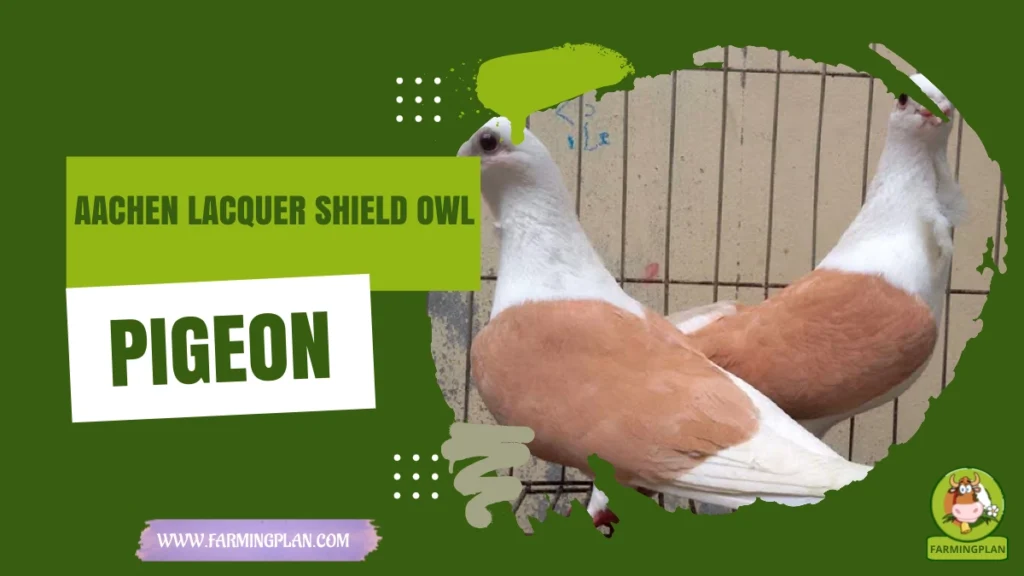If you’re into fancy pigeons, the Barb Pigeon is a real standout. With its short beak, unique face, and calm nature, it’s a favorite among breeders, pet owners, and pigeon hobbyists alike. I’ve raised a few myself, and they always add charm and character to the loft. Originally bred for their looks and sweet temperament, Barbs are easy to care for and enjoy social settings. Whether you’re showing them off or simply enjoying their company, they’re a joy to have around. In this guide, I’ll cover everything from their history and traits to feeding, health care, and daily tips to keep them happy.
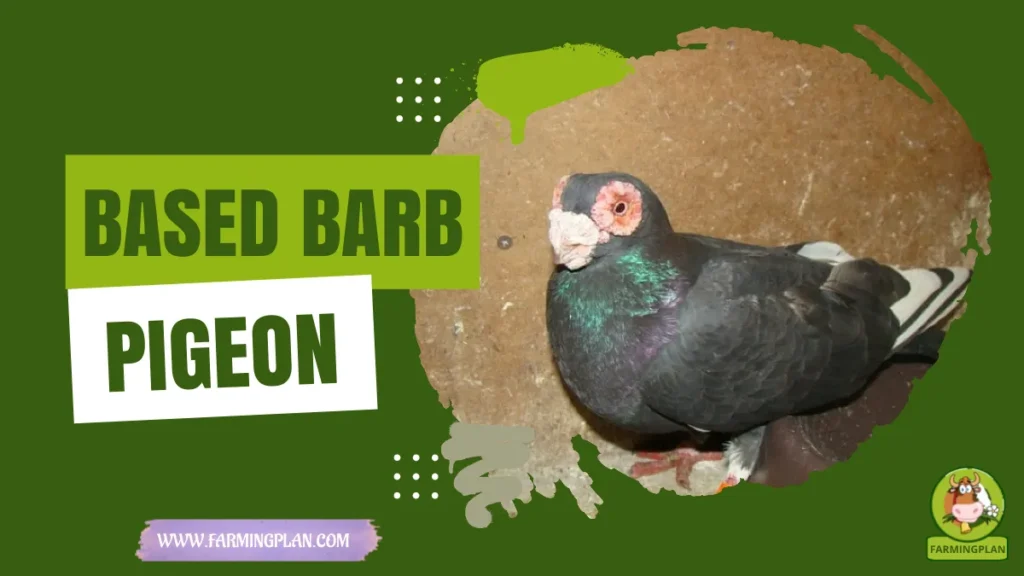
History & Origin of Barb Pigeon
The Barb Pigeon is one of the oldest known fancy pigeon breeds. It dates back hundreds of years and has been admired across Europe for its unique appearance and steady demeanor. Historians believe the breed originated in North Africa and made its way to Europe through trade and travel during the early modern period.
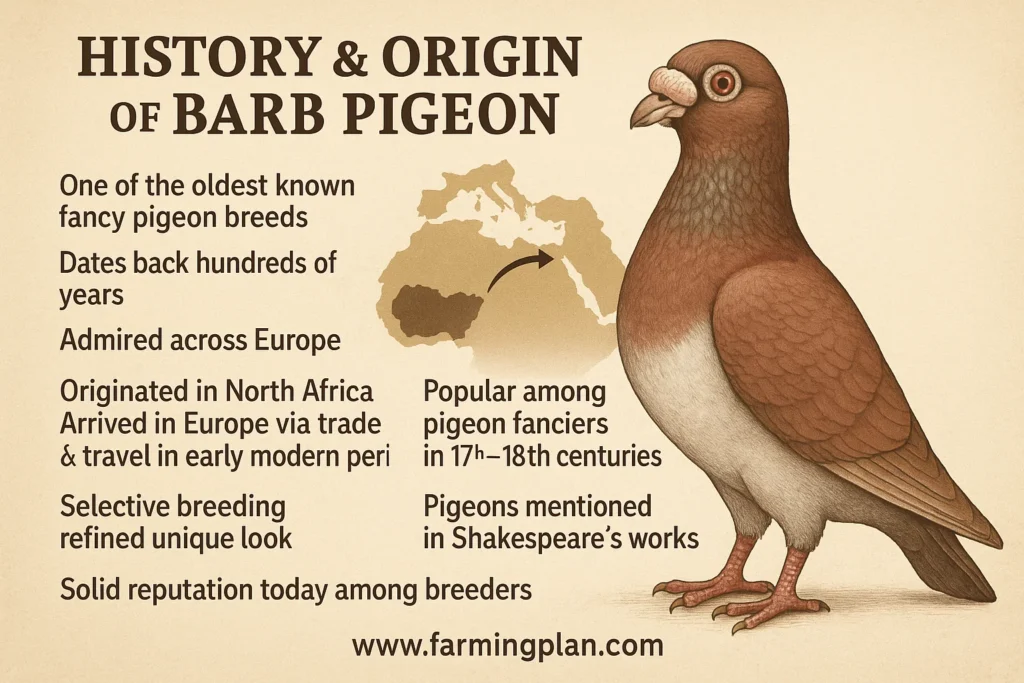
In England, the Barb was especially popular among pigeon fanciers in the 17th and 18th centuries. Even Shakespeare mentioned pigeons in his works—and although he didn’t call out the Barb by name, pigeons were already considered prized birds in his time. Selective breeding further refined its look, resulting in the Barb’s signature beak and compact build. Today, the Barb Pigeon continues to enjoy a solid reputation among breeders and enthusiasts, particularly in the UK and parts of Asia.
Read More: Giant Runt Pigeon: Amazing Breed With Giant Size and Charm
Characteristics of Barb Pigeon
Barb Pigeons are known for their elegant appearance and compact build. One of their standout features is the short, stout beak with a prominent cere (the fleshy area above the beak), which gives the bird a very distinguished profile. Their body is short and strong, with a slightly upright posture.
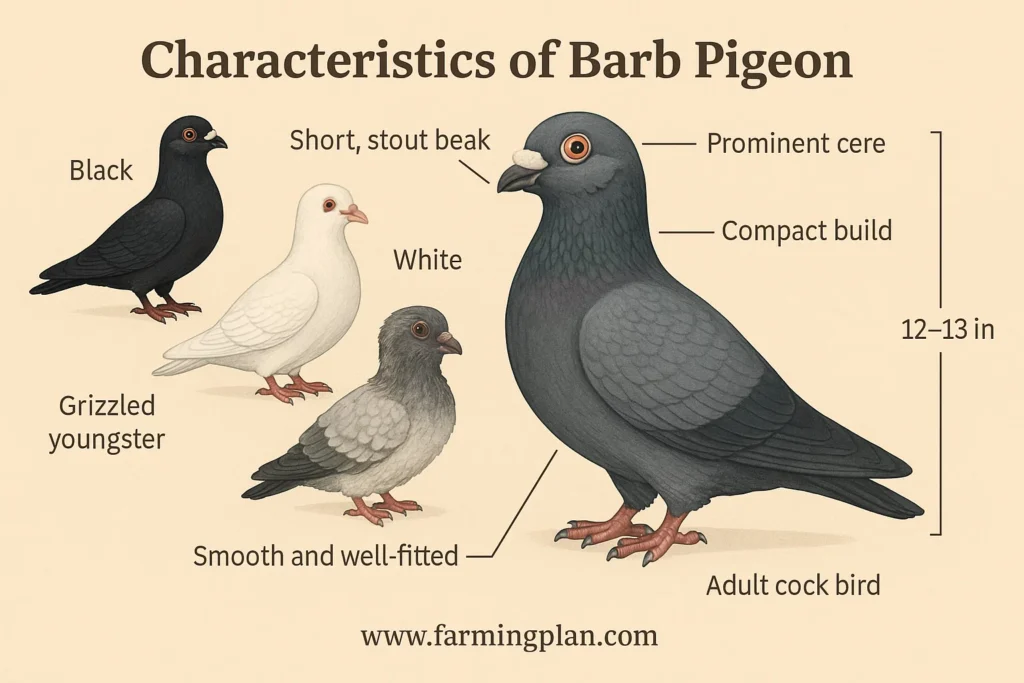
They come in a variety of colors including black, white, red, and grizzled. The grizzled youngster variety—which sports a mix of light and dark feathering—is especially admired by collectors. The feathers are smooth and well-fitted, giving the bird a neat appearance. You can also spot different age classes among them, from the fluffy youngsters to the sleek adult cock birds. These birds usually grow to about 12-13 inches in length and weigh just under a pound. Their calm demeanor and neat grooming make them ideal candidates for fancy pigeon shows and home lofts alike. With proper care, Barb Pigeons can live for [10-15 years], making them a long-term companion.
Barb Pigeons May Not Be The Fastest Flyers, But Their Beauty And Charm Can Steal Any Bird Lover’s Heart.
Nature & Temperament of Barb Pigeon
One of the reasons I enjoy keeping Barb Pigeons is their mellow temperament. They’re calm, rarely aggressive, and easy to handle—perfect for beginners or anyone looking for a gentle pet. Even cock birds, which in some breeds can be feisty, are generally well-mannered among Barbs.
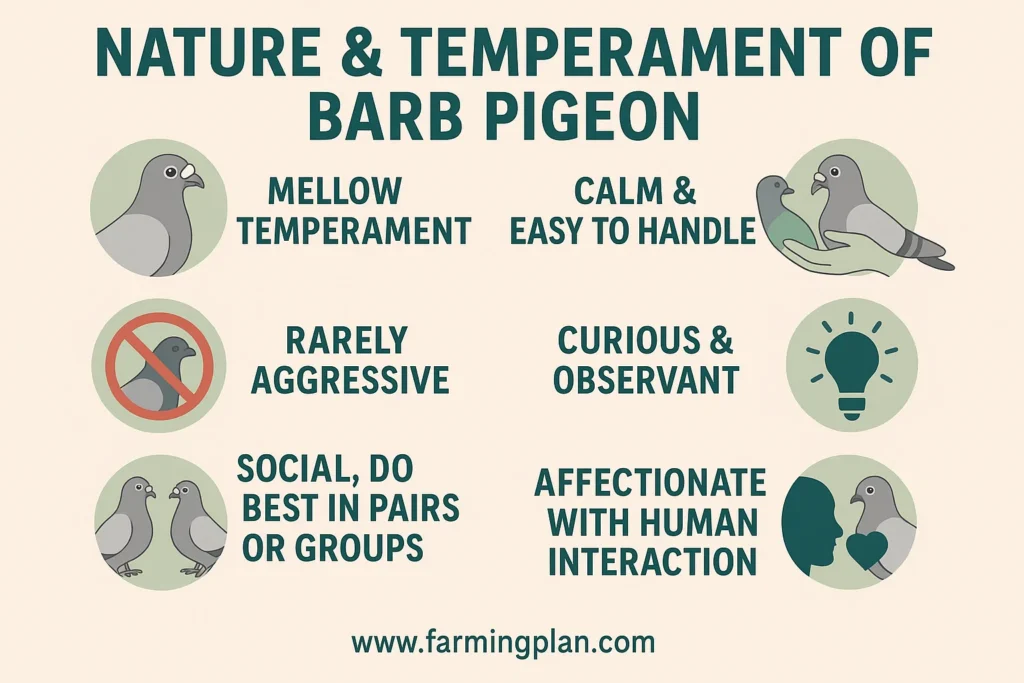
Barbs are curious and like observing their surroundings. While they’re not as hyperactive as some flight breeds like Tippler Pigeons, they enjoy a bit of low-level flying and exploring within enclosed areas. Because of their social nature, they do best in pairs or small groups. If you’re raising them as pets, they can even become quite affectionate with regular human interaction.
Read More: Amazing American Giant Runt Pigeon: The Ultimate Utility Bird
Food & Diet
Feeding Barb Pigeons is fairly straightforward. I offer mine a balanced pigeon mix that includes grains like corn, wheat, millet, and peas. They need access to clean, fresh water at all times—hydration is crucial, especially during molting or hot weather.
Supplementing with grit helps their digestion, and I sometimes toss in fresh veggies like chopped spinach or grated carrots. Avoid giving them bread, salty snacks, or sugary foods—these can lead to digestive issues or obesity. And don’t forget calcium supplements if you’re breeding—strong eggshells depend on it. A typical feeding schedule for a Barb Pigeon includes [two meals a day, each consisting of a quarter cup of pigeon mix and a small handful of grit, with occasional treats of fresh vegetables].
Read More: Indian Fantail Pigeon: Stunning Yet Challenging
Usage & Purpose
Barb Pigeons are mainly kept for ornamental and show purposes. Their unique look makes them stand out in fancy pigeon competitions, where judges score based on symmetry, feather quality, posture, and color.
Though they aren’t known for strong flying abilities like Tipplers or Homers, they do just fine in aviaries or enclosed outdoor lofts. Some breeders even pair them with other breeds like the Frill Pigeon or Carneau Pigeon to experiment with features. But purebred Barbs are often preserved for their historical and aesthetic value. If you’re interested in breeding Barbs, it’s important to provide them with a [separate breeding loft with nesting boxes and privacy]. Once the eggs are laid, ensure they are kept warm and turned regularly. When the chicks hatch, provide them with [a warm, draft-free environment and a diet high in protein].
Special Features
Barb Pigeons have a number of traits that set them apart. The most iconic is the beak—short, thick, and with a noticeable cere that makes them look noble and wise. Their small but solid body structure helps with stability, while the eye color can vary from pearl to dark, depending on feather coloration.
Another thing I love? They’re quiet birds. If you’ve ever owned a loud, cooing breed, you’ll appreciate the Barb’s subtle presence. They’re also surprisingly hardy, able to adapt to different temperatures and conditions as long as their basic needs are met.
Health Issues & Prevention
Like all pigeons, Barbs can suffer from respiratory issues, lice, mites, and digestive problems. That’s why I always keep a clean loft, ventilated and dry. Regularly check for signs of illness like nasal discharge, fluffed-up feathers, or changes in droppings.
Vaccinate your birds for paramyxovirus and keep a worming schedule. If a pigeon looks unwell, isolate it right away to prevent spreading illness. Clean feeders and waterers daily, and use natural disinfectants like apple cider vinegar in the water every now and then to boost their gut health.
Step-by-Step Pet Owner Care Guide: Raising a Happy Barb Pigeon
Raising a Barb Pigeon isn’t just about feeding and cleaning—it’s about building a peaceful home where these unique birds can thrive. With their distinctive faces and calm personalities, Barbs make charming companions, but they do best when their needs are truly understood. Whether you’re a beginner or a seasoned bird lover, this guide will walk you through each step to ensure your Barb stays healthy, happy, and well cared for.
Step 1: Set Up the Perfect Home
Your Barb Pigeon’s comfort begins with the right housing. I recommend starting with a spacious, well-ventilated loft or walk-in aviary that’s protected from predators like cats, snakes, or hawks. Even though Barbs aren’t strong flyers due to their short beaks and face shape, they still love hopping between perches and nesting spots.
Make sure the floor is easy to clean and slightly sloped for drainage. Use natural bedding like straw or wood shavings and clean the space at least once a week. Keep the area dry and draft-free, especially in colder seasons, to prevent respiratory issues.
Tip: A couple of wooden nest boxes per pair can go a long way in making your Barbs feel right at home.
Step 2: Choose the Right Companions
Barb Pigeons are social by nature, so they don’t do well alone. Always keep them in pairs or small flocks. They bond closely with their mate and often stick together like a sweet old couple. Just avoid housing them with aggressive breeds like Tipplers or Racers, as Barbs are too gentle to defend themselves. When introducing new birds, always quarantine them for a couple of weeks. It helps prevent disease spread and gives everyone time to adjust without stress. Once the new bird passes health checks, introduce them slowly by placing cages side by side for a few days before allowing full interaction.
Step 3: Feed Daily With Care
A balanced diet keeps your Barbs looking sharp and staying healthy. Start each morning with a good quality pigeon grain mix. You can find blends that include corn, wheat, peas, and millet. During breeding or molting, I add pigeon pellets or a protein booster for extra support. Fresh, clean water must be available at all times—Barbs won’t drink if the water’s dirty. I also provide a dish of grit or crushed oyster shell to help with digestion and calcium intake. You can occasionally offer chopped leafy greens, boiled eggs, or even some carrots for vitamins.
Tip: During hot days, I add a splash of apple cider vinegar to the water to boost immunity and prevent bacterial buildup.
Step 4: Monitor Health Weekly
Barb Pigeons are usually hardy, but because of their short beaks and facial structure, they can be prone to eye and respiratory issues. I do a weekly health check—looking at eye clarity, feather condition, breathing, and droppings. Red, watery eyes or wheezing can be signs of trouble. Look out for mites or lice, especially around the neck and tail. A dusting powder or a pigeon-safe mite spray can prevent outbreaks. Keep their coop clean and dry to avoid fungal or bacterial growth. If a bird seems off—fluffed up, eating less, or lethargic—separate it right away and monitor closely.
Step 5: Build Trust With Time
Barbs are calm but shy at first. They don’t respond well to loud noises or sudden movements, so be gentle and patient. I always start by sitting near their aviary and talking softly. After a few days, I’ll start offering treats like sunflower seeds by hand. Over time, they’ll recognize your voice and presence as a source of comfort. Some Barbs may even hop onto your lap or shoulder with enough trust. Remember, trust takes time—but once they bond with you, it’s a special connection that makes every effort worthwhile.
Step 6: Prepare for Breeding (If Needed)
Thinking about breeding your Barbs? Start by setting up cozy nest boxes in quiet corners of the aviary. I use soft straw or shredded newspaper for bedding. Keep one nest box per pair to avoid fights. Once the pair mates, the female usually lays two eggs.
Make sure both parents have access to extra calcium (like crushed eggshells or cuttlebone) and a protein-rich diet during this time. When the chicks hatch, they’ll be fed crop milk by their parents for the first few days. I always keep the loft warm and draft-free during this stage to protect the babies. Keep an eye on the chicks’ growth. They’ll fledge in about 4 weeks. At that point, you can separate them gently to start taming or to let them grow into the next generation of show-worthy Barbs!
Expert Tips & Best Practices for Barb Pigeon Owners
- Always quarantine new birds for at least 2 weeks.
- Use a deep-litter system for easier cleaning.
- Rotate grains every few weeks to keep the diet interesting.
- Offer occasional flight time in a secure aviary.
- Label breeding pairs to track genetics and avoid inbreeding.
- Handle your birds gently and regularly for better bonding.
- Keep the loft calm and quiet—Barbs don’t thrive in chaos.
FAQ
What is the price of a Barb Pigeon?
Prices vary, but purebred Barb Pigeons usually cost between $50 and $150 depending on age, lineage, and breeder reputation.
Are Barb Pigeons good pets?
Yes, they are gentle, calm, and enjoy social interaction. They’re ideal for beginners and experienced keepers alike.
Can Barb Pigeons fly well?
They can fly short distances, but they are not strong fliers like Tippler or Homing Pigeons.
What do Barb Pigeons eat?
A diet of pigeon grains, grit, fresh greens, and clean water keeps them healthy and active.
Where can I find Barb Pigeons for sale?
Look for reputable breeders online, at bird shows, or in pigeon fancier groups and forums.
Conclusion
Raising Barb Pigeons has been one of the most rewarding experiences for me as a bird lover and farmer. They’re beautiful, easy to manage, and bring a unique presence to any loft. Whether you’re breeding for shows, looking for a gentle pet, or just want to admire their elegant charm, the Barb is a top pick. Their rich history, special features, and good-natured temperament make them a treasure among fancy pigeon breeds. If you’re thinking about adding a new feathered friend to your flock, I wholeheartedly recommend the Barb Pigeon—they’re more than just fancy birds; they’re companions with character. Let me know if you take the plunge—I’d love to hear how it goes!

